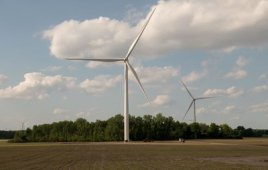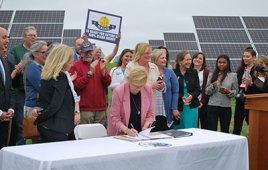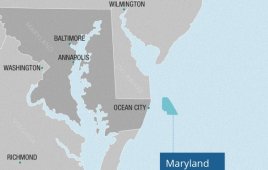After catching up with GE at the AWEA show, the large OEM has lot of news to share.
For one, the company unveiled its latest model, the 1.6-100, at the show and has already secured nearly 630 ME of commitments for the turbine they designed for increased performance in areas with lower wind resources. The company says the 1.6-100 is the most efficient wind turbine when taking into account capacity factor in wind class. With blades that extend 100 me—a height of 33 stories—the 1.6-100 has the ability to capture additional energy, making it well suited to a variety of wind farm locations. The turbine also offers a 47% increase in swept area over previous models, resulting in a 19% increase in annual energy production at 7.5 m per second. This allows for the turbine to deliver IEC Type Class II performance while operating in a Type Class III (low wind) environment. GE has been operating a prototype 1.6-100 wind turbine at its Tehachapi, Calif., site since February of 2011.
In addition, three Brazilian companies have selected the 1.6-100 for 256 MW of projects in the country. GE will provide 106 wind turbines to projects developed by Serveng Civilsan, 36 wind turbines to projects developed by Bioenergy and 18 wind turbines to projects developed by Oleoplan for a total of 160 turbines to be delivered in 2012.
The company has also expanded its wind services portfolio to include production based availability (PBA) guarantees as an option for new and existing operations and maintenance contracts on all GE 1.5 and 2.5-MW series wind turbines. Available later this year, GE’s production guarantees have been designed with the goals of its customers in mind; ensuring that wind turbines are available during the high wind periods which can be the most profitable for turbine owners.
The company says in 2010, their North American 1.5-MW wind turbines achieved 98.6% fleet-wide time-based availability, with a global average of more than 98%. Wind turbine availability is an important measurement of how well a wind farm is operating and is representative of the amount of time a turbine is able to produce power. GE’s PBA guarantee takes into consideration availability, while at the same time balancing peak production on turbines wind-farm wide. While keeping time-based availability high will continue to be important, factoring in key performance trends gives GE’s wind services team a better perspective on how to best operate a site.
Lastly, as if that’s not enough, work on the world’s largest wind project is well under way as the first wind turbines have arrived at the Shepherds Flat site in Oregon. More than 200 GE wind turbines are expected to arrive at the site before the end of this year, with the remaining units to be shipped in 2012. Shepherds Flat will be the first project in the United States to use GE’s 2.5-100 wind turbines, which have logged more than 2.3 million operating hours in Europe and Asia.
Stretching across 30 square miles of north-central Oregon, the Shepherds Flat project will include 338 GE 2.5-100 wind turbines and will have a total capacity of 845 MW, enough clean energy for 235,000 households. When completed in 2012, Shepherds Flat will be larger than any wind farm currently in operation in the United States. Some of the largest components for the Shepherds Flat 2.5-100 wind turbines, including the machine heads and hubs, are being built at GE’s Pensacola, Fla., and Tehachapi, Calif., facilities. The first hubs for the project came off the line in Tehachapi in February, while production of machine heads began in Pensacola earlier this year.
The Shepherds Flat wind farm is owned by developer and managing member Caithness Energy, along with GE Energy Financial Services, Google and subsidiaries of ITOCHU Corporation and Sumitomo Corporation. Total project value is approximately $2 billion. The wind farm has put in place three 20-year power purchase agreements with Southern California Edison, helping California meet its renewable energy goals.
GE www.ge.com
Filed Under: Uncategorized






